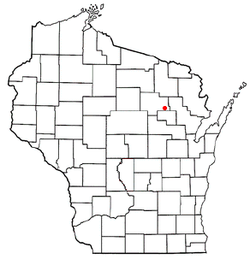White Lake, Wisconsin
| White Lake | |
|---|---|
| Village | |
 Location of White Lake, Wisconsin |
|
| Location of White Lake, Wisconsin | |
| Coordinates: 45°9′24″N 88°45′56″W / 45.15667°N 88.76556°WCoordinates: 45°9′24″N 88°45′56″W / 45.15667°N 88.76556°W | |
| Country | United States |
| State | Wisconsin |
| County | Langlade |
| Area | |
| • Total | 2.47 sq mi (6.40 km2) |
| • Land | 2.18 sq mi (5.65 km2) |
| • Water | 0.29 sq mi (0.75 km2) 11.74% |
| Elevation | 1,286 ft (391.9728 m) |
| Population (2010) | |
| • Total | 363 |
| • Estimate (2012) | 356 |
| • Density | 166.5/sq mi (64.3/km2) |
| Time zone | CST (UTC-6) |
| • Summer (DST) | CDT (UTC-5) |
| Zip Code | 54491 |
| Area code(s) | 715 & 534 |
| FIPS code | 55-86750 |
| GNIS feature ID | 1580775 |
White Lake is a village in Langlade County, Wisconsin, United States. The population was 363 at the 2010 census.
The name "White" was given to the lake by the Indians who hunted and fished in the area many years ago. It was so named because of the white sand and marl in the lake bottom. In 1876, pioneer Isaac Farrow attempted to drain White Lake and make a hay meadow out of the level bottom. He failed in this venture because he didn't realize the depth of the lake and the fact that it was fed by springs.
The White Lake area lies south and west of a former terminus of the Wisconsin and Northern Railroad, Van Ostrand. Service began running between Shawano and Van Ostrand in late 1907. Settlement in the area began to show preference to the White Lake area over Van Ostrand, a process that was accelerated by the construction of a new lumber mill completed at the end of 1916. The Wisconsin Northern moved its depot from Van Ostrand to White Lake at approximately that time. Van Ostrand was ultimately abandoned, while White Lake was incorporated as a village in 1926.
White Lake is located at 45°9′24″N 88°45′56″W / 45.15667°N 88.76556°W (45.156596, -88.765597), in the eastern part of Langlade County about four miles west of the Wolf River and Wisconsin Highway 55. It is surrounded by the Town of Wolf River.
According to the United States Census Bureau, the village has a total area of 2.47 square miles (6.40 km2), of which, 2.18 square miles (5.65 km2) of it is land and 0.29 square miles (0.75 km2) is water.
As of the census of 2010, there were 363 people, 156 households, and 100 families residing in the village. The population density was 166.5 inhabitants per square mile (64.3/km2). There were 212 housing units at an average density of 97.2 per square mile (37.5/km2). The racial makeup of the village was 96.4% White, 0.3% Asian, and 3.3% from two or more races. Hispanic or Latino of any race were 2.5% of the population.
...
Wikipedia

